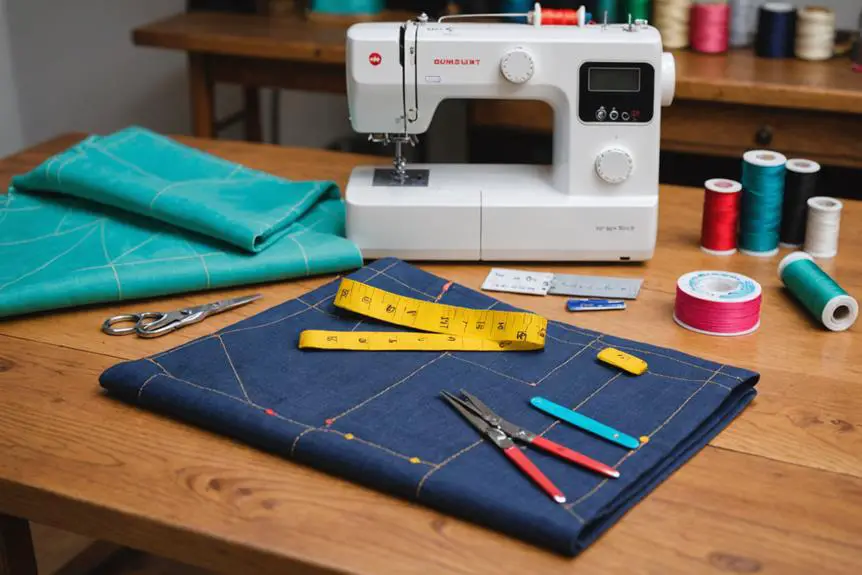When you think about tailoring trousers, it's not just about making them fit better; it's about enhancing your overall look and comfort. You'll want to start by gathering the right materials and taking precise measurements. Once you've got that down, adjusting the waist and legs can make a significant difference. But what if there are common fit issues you hadn't considered? Understanding those can truly elevate your tailoring skills, and it's essential to know the best techniques for hemming. Let's explore how to tackle these challenges effectively.
Importance of Tailoring
Tailoring is essential for achieving the perfect fit in your trousers, and it can make all the difference in how you look and feel. Let's be honest, off-the-rack pants often aren't made for your unique shape. They can leave you with excess fabric, making you feel uncomfortable and not quite right. That's where tailoring steps in! A professional tailor can work wonders, ensuring your trousers hug your body in all the right places. For instance, focusing on adjusting the waist and tapering the legs can greatly enhance your silhouette, making it more flattering and stylish. Tailoring vintage bottoms is a great way to achieve that polished look.
When you tailor your pants, you're not just altering a garment; you're transforming your entire look. A good fit boosts your confidence and makes you feel like a million bucks! You might be wondering, "How do I measure how much fabric to take in?" Well, it's simpler than you think. Just pay attention to those loose waistbands or baggy thighs. A little adjustment can elevate your style from "meh" to "wow" in no time!
Plus, if you're feeling adventurous, you can even try DIY tailoring! It's a fun way to save some cash and take control of your style. Not to mention, it's incredibly satisfying to see your efforts pay off with a perfect fit. So, whether you head to a professional tailor or roll up your sleeves and do it yourself, remember: tailoring is the key to revealing the best version of your trousers. Are you ready to make that leap? Your wardrobe will thank you!
Materials Needed for Alterations
Ready to tackle your trousers? You'll need some essential tools like a seam ripper, fabric scissors, and pins to get started on those alterations. Consider gathering materials that offer unique textures and colors, as this can greatly enhance your final look unique textures for patches. Don't forget your measuring tape and tailor's chalk—these little helpers will make sure you get the fit just right!
Essential Sewing Tools
When you're gearing up to tailor trousers, having the right tools at your fingertips can make all the difference. First up, grab a seam ripper. It's your best friend for removing those pesky stitches without ruining your fabric. Next, don't forget your fabric scissors for cutting away any excess material—trust me, dull scissors are a nightmare!
A measuring tape is vital for getting those adjustments just right. You want your trousers to fit like a glove, right? And speaking of fit, tailor's chalk is essential for marking where you need to cut or sew without leaving a permanent mark. You'll be glad you used it!
Now, let's talk about securing your fabric. Pins will hold everything in place while you work, so you don't end up with a surprise hemline. Finally, you'll need a sewing machine or some solid hand-sewing skills to finish off those alterations neatly.
Oh, and don't skip the ironing board and iron! Pressing those seams and hems gives your trousers that polished look. So, are you ready to tackle those alterations? Let's get sewing!
Fabric Measurement Techniques
Before you start making any alterations, it's crucial to get accurate measurements of your trousers. You'll want to grab a measuring tape and measure your waist, hips, and inseam. Seriously, measuring twice and marking once is the golden rule—this way, you won't end up with pants that are too short or too loose!
Now, when you mark your fabric, tailor's chalk is your best friend. It creates clear lines that you can easily follow while you stitch along. But hey, if you're looking to adjust seams or hems, don't forget your trusty seam ripper. It helps you remove stitches without damaging the fabric, which is a total lifesaver!
Once you've made your marks, use pins to secure the fabric in place during the alteration process. This lets you make adjustments easily before you commit to that final stitch. Remember, a little patience goes a long way! So, take your time with those measurements and enjoy the transformation of your trousers. With these tips, you'll have perfectly tailored pants in no time, and you'll be strutting in style!
Marking and Securing Fabric
To achieve a successful alteration, you'll need a few crucial materials that make the process smoother. When you're ready to tackle those trousers, don't forget these key items to help you mark around and secure fabric effectively.
- Measuring Tape: This is your best friend for guaranteeing everything's even. You'll want to measure twice before cutting once!
- Tailor's Chalk: Use this to mark where you need to pinch the excess or make adjustments. It washes out easily, so no worries about permanent marks!
- Pins: These little guys are essential for securing fabric while you work. They keep your alterations in place, preventing any shifting as you sew.
- Fabric Scissors: Invest in a good pair to guarantee you cut cleanly and avoid frayed edges. Trust me, your trousers will thank you!
As you work, take your time to mark around the belt loops and other details. They can be tricky! With the right tools, you'll feel like a pro in no time. Happy tailoring!
Adjusting Waist and Legs
Ready to give those trousers a perfect fit? Adjusting the waist and legs can really make a difference in how you look and feel, so let's get started! Whether you're tackling a baggy waist or legs that need a little tapering, you'll be strutting in style in no time!
Waist Adjustment Techniques
Adjusting the waist of trousers is a straightforward process that can greatly enhance your fit and comfort. You'll be amazed at how much better your pants can feel! Here's how to do it:
- Pinch and Mark: First, try on the pants and pinch the excess fabric at the waist. Use pins or tailor's chalk to mark where you want to remove about 1 to 3 inches.
- Get Your Tools: Grab a seam ripper to carefully remove the back belt loop and open the waistband seam. This gives you easy access to make the adjustments.
- Sew It Up: Now, sew along the line where you marked. Make sure to keep everything neat! Once you're done, fold the waistband back into place and reattach the belt loop.
- Final Touches: Always try on the pants again to verify they fit you well. If you need to tweak anything further, don't hesitate to do so!
Leg Tapering Methods
Once you've tailored the waist of your trousers for a better fit, the next step is to tackle the leg tapering for a sleek silhouette. You want your pants to fit your body just right, so start by trying them on. Use fabric chalk to mark where you want to taper around the calf and ankle. This gives you a clear guide for your transformation!
Now, measure how much you'll remove from each leg. Aim for a smooth tapering line that slopes evenly from the knee to the ankle. This balance is key for a polished look. Once you've got your measurements, it's time to sew! Stitch along the marked line, but be careful—remove those pins as you go to avoid any sewing mishaps!
After you've finished sewing, trim any excess fabric, then re-hem your trousers. Leave about a 1-2 inch hem allowance for that neat finish. Remember, trying on the pants multiple times during this process helps guarantee they fit perfectly. So, are you ready to rock those tailored trousers? Let's do this!
Hemming Techniques Explained
Hemming is an important skill for anyone looking to achieve the perfect fit in their trousers. If you've ever struggled with trousers that are just a bit too long, you know how significant it is to master this technique! Proper fitting is vital to guarantee comfort and mobility, similar to evaluating the fit of a vintage varsity jacket evaluating your jacket fit. Let's explore some simple steps to help you get that flawless hemline.
- Measure Your Desired Length: Start by trying on your trousers and measuring where you want the hem to fall. Pin it in place to keep it steady.
- Cut with Precision: With your trousers inside-out, use a seam ripper to remove any original stitches if necessary. Then, trim the excess fabric, leaving about 2.5 cm (1 inch) for a double-fold hem.
- Double-Turn the Hem: Fold the fabric up twice to create a clean finish. This keeps the hem from fraying and looks polished. Secure it with pins to keep everything in place.
- Stitch it Down: Using a straight stitch, sew along the hemline. Be careful not to bunch the fabric—smooth is the name of the game!
Common Fit Issues
Finding the right fit for trousers can be a challenge, especially when you're dealing with common issues that affect comfort and style. You've probably noticed that pants can fit snugly in the bum while feeling loose around the waist. It's like they just can't make up their mind! This often means you'll need alterations to adjust both the seat and the waistband. Many people also struggle with the fit of their trousers due to variations in body shape, making it vital to assess fit and measuring for adjustments.
If you've got a larger hip size compared to your waist, you know the struggle of finding ready-to-wear sizes that feel comfortable. It's frustrating, right? And let's not forget about pants that are too long. They can bunch up at the ankles, and nobody wants that. A proper hem is vital for a polished look.
Loose waistbands can lead to all sorts of discomfort and slippage, making you constantly readjust your pants. Talk about a distraction! That's why getting your waist tailored for a snug fit is essential.
Understanding your unique body shape can really change the game. By addressing these fit issues through tailored alterations, you can enhance not only your comfort but also your self-image. So, don't hesitate to consult a tailor! You'll be surprised at how a few tweaks can make your trousers fit just right. After all, the right fit can boost your confidence and style. Who wouldn't want that?
Recommended Resources for Tailoring
When it comes to tailoring trousers, having the right resources can make all the difference. You want to feel confident in your alterations, and luckily, there are plenty of tools and guides to help you achieve that perfect fit. Here are some recommended resources that you shouldn't skip:
- "Ahead of the Curve" by Jenny Rushmore – This book offers detailed instructions on tailored fitting, including those tricky adjustments for full bums and poochy tummies. It's a must-read!
- Online Tutorials – Immerse yourself in the world of alteration techniques through various online platforms. You'll find videos and step-by-step guides that cater to all skill levels—perfect for picking up new tricks.
- Nancy Zeiman's Fitting Methods – Explore different approaches to fit through Nancy Zeiman's methods. Comparing these techniques can help you find what works best for your style and body shape.
- Sewing Community – Engage with a supportive sewing community. Sharing your experiences and learning from others can provide invaluable insights into fitting challenges and successful alterations.
Before you jump into altering brand-new trousers, practice on old garments. It's a great way to build your skills, boost your confidence, and minimize mistakes. So, grab those unused clothes and get to work! With these resources in your toolkit, you'll be well on your way to creating trousers that fit like a dream!
Frequently Asked Questions
How to Tailor Your Own Trousers?
To tailor your trousers, gather alteration tools, choose fabric types, and assess trouser length. Use fitting techniques to mark adjustments and apply hemming methods that match your style preferences for a polished look.
How to Tailor Pants That Are Too Big?
To tailor pants that are too big, start by measuring the waist, adjusting the inseam, tapering legs, and adding darts. Don't forget to shorten hems and repair seams for a perfect fit.
Can a Tailor Make Trousers Slimmer?
Imagine slipping into perfectly fitted trousers. Yes, a tailor can make them slimmer through leg tapering, waist adjustments, and professional alterations. Different fabric types offer various style options, ensuring you'll look sharp and feel comfortable.
Can Trousers Be Altered?
Yes, trousers can be altered! You can enjoy trouser fitting through various alteration techniques like waist resizing and hem adjustments. Choose fabrics that complement your personal style, ensuring a comfortable and stylish fit that reflects you.





Venture into the stunning galaxy of EVE Online. Become a legend today. Fight alongside millions of explorers worldwide. [url=https://www.eveonline.com/signup?invc=46758c20-63e3-4816-aa0e-f91cff26ade4]Play for free[/url]